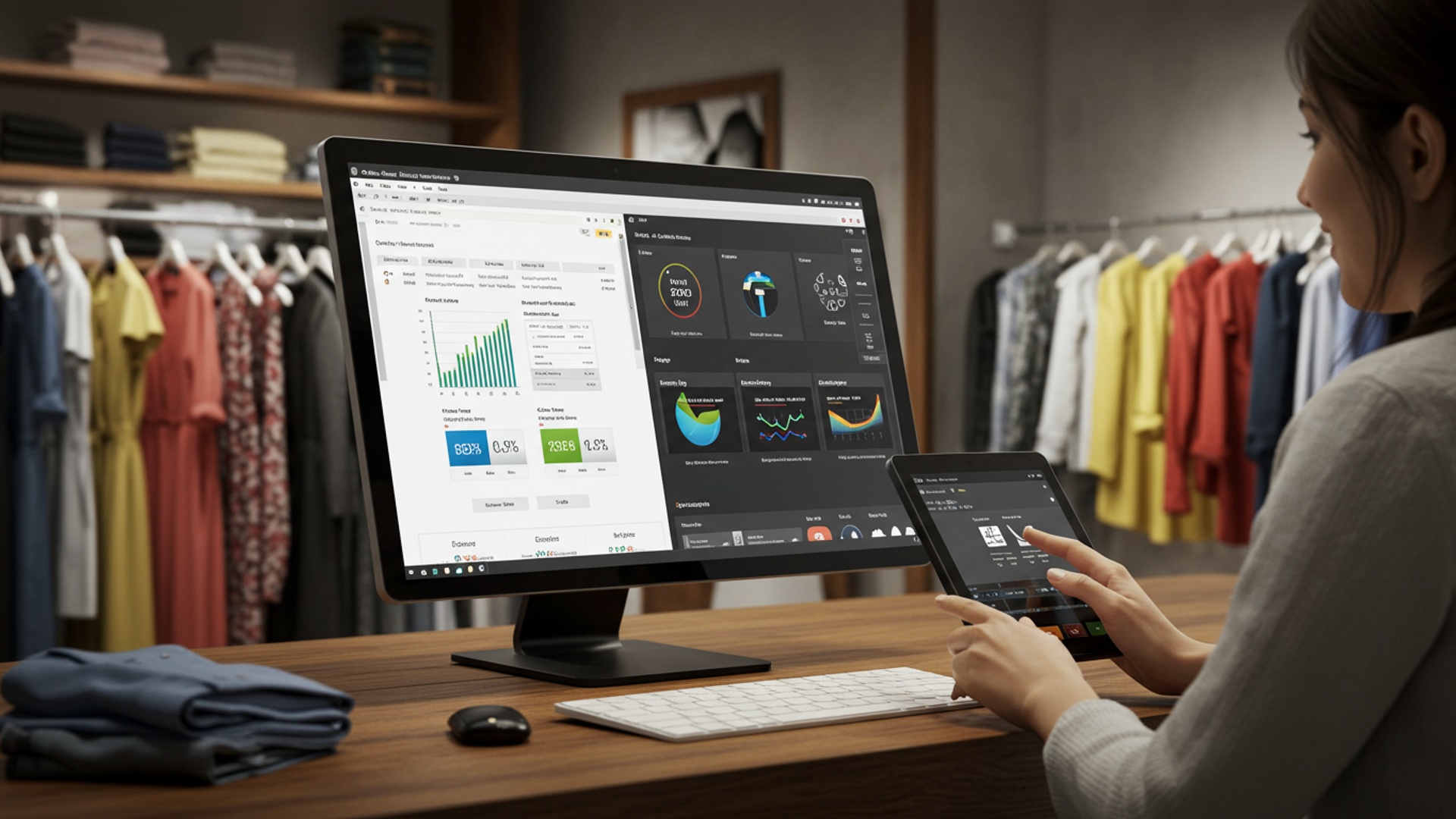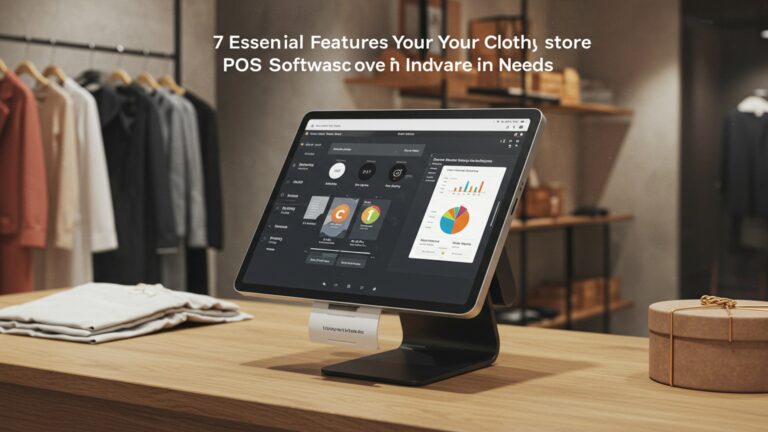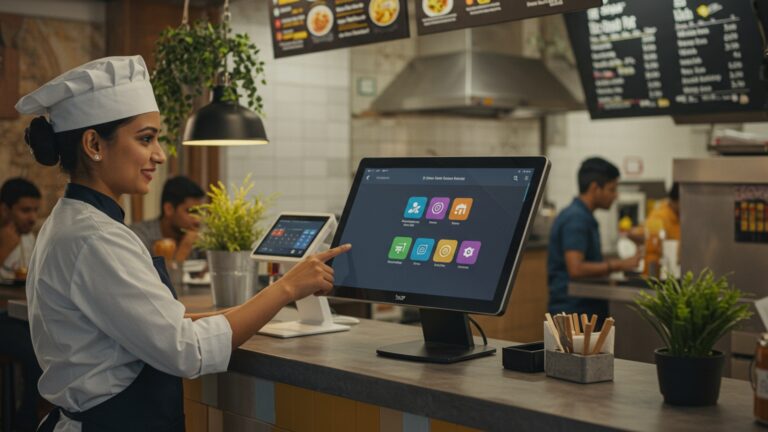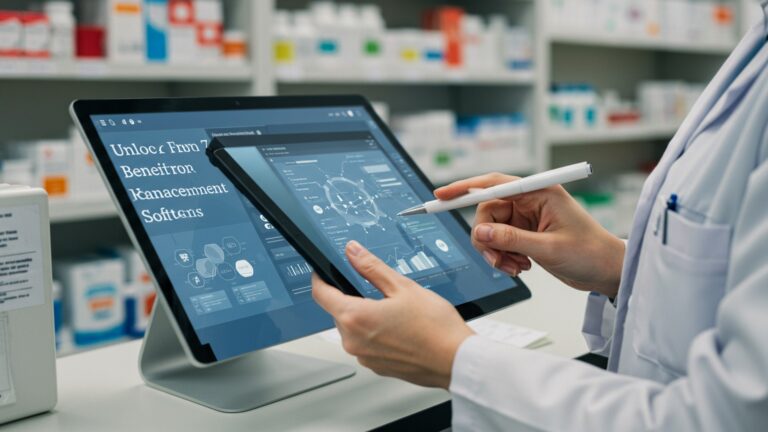7 Essential Features Guide for Clothing Store POS Software India
In India’s dynamic retail landscape, where consumer preferences shift rapidly and omnichannel experiences are paramount, a modern clothing store pos software india solution transcends mere transaction processing. Savvy retailers now leverage advanced POS systems not just for sales but as a strategic backbone, integrating real-time inventory across multiple outlets, personalizing customer interactions through loyalty programs. streamlining staff management for peak efficiency. The right software empowers businesses to make data-driven decisions, anticipate seasonal demands. offer a seamless shopping journey whether a customer is browsing a boutique in Delhi or an e-commerce platform nationwide, ensuring competitive edge and sustainable growth.

Robust Inventory Management and Tracking
For any clothing store, managing inventory is paramount. a top-tier clothing store POS software in India must excel here. This feature goes beyond simply counting items; it encompasses a sophisticated system to track every SKU (Stock Keeping Unit) with precision. In the fashion retail landscape, this means handling variations in size, color, style. fabric for each product.
- SKU Management
- Real-time Stock Updates
- Multi-Location Tracking
- Barcode and RFID Integration
- Stock Alerts and Reorder Points
Efficient creation and categorization of products, allowing for unique identifiers for each variant (e. g. , “Men’s T-shirt – Blue – Large”). This is critical for preventing overselling or stockouts.
As soon as a sale is made or an item is returned, the inventory count should update instantly across all sales channels, including your physical store and any integrated e-commerce platform.
If your clothing business operates multiple outlets or a central warehouse, the software should provide a consolidated view of inventory across all locations, facilitating inter-store transfers and optimized stocking.
Support for barcode scanners speeds up checkout and stock auditing. Advanced systems may integrate with RFID (Radio-Frequency Identification) for even faster and more accurate inventory counts, reducing manual effort significantly.
Automated alerts notify you when stock levels fall below a predefined threshold, prompting timely reorders to avoid lost sales.
A practical application is a boutique owner in Bengaluru who, using such software, can instantly check if a customer’s desired size of a particular dress is available at their other outlet in Mumbai, or if it’s due for restock, enhancing customer service and sales opportunities.
Seamless Sales and Transaction Processing
The core function of any POS system is to handle sales transactions smoothly and efficiently. For a clothing store POS software in India, this means a user-friendly interface that speeds up the checkout process, minimizing customer wait times and improving the overall shopping experience.
- Quick Product Search
- Flexible Payment Options
- Returns, Exchanges. Refunds
- Discount and Promotion Management
- Sales Hold and Recall
- Receipt Customization
Ability to quickly find items by barcode scan, SKU, product name, or category.
Support for various payment methods popular in India, including cash, debit/credit cards (via integrated card readers), UPI, mobile wallets (e. g. , Paytm, Google Pay). even EMI options.
A streamlined process for handling customer returns, exchanges for different sizes/colors. issuing refunds, including partial refunds. The system should automatically adjust inventory and sales records.
Capability to easily apply various discounts (percentage, fixed amount), run promotions (e. g. , “Buy One Get One Free,” seasonal sales). manage loyalty points redemption directly at checkout.
Allowing cashiers to temporarily hold a transaction for a customer and recall it later, useful during busy periods or when a customer needs to fetch another item.
Generating professional-looking receipts that can be printed or sent digitally via email/SMS, often including store branding, return policies. promotional messages.
Consider a retail chain in Delhi during Diwali season. A robust clothing store POS software in India allows them to process hundreds of transactions quickly, apply complex festive discounts. manage returns post-festival without any operational bottlenecks.
Comprehensive Customer Relationship Management (CRM)
In the competitive Indian retail market, fostering customer loyalty is key. A sophisticated clothing store POS software in India integrates robust CRM functionalities to help businesses comprehend their customers better and tailor experiences.
- Customer Database
- Loyalty Programs
- Targeted Marketing
- Wishlist and Purchase History
- Feedback Collection
Building a centralized database of customer data, including purchase history, contact details, preferences. loyalty program status.
Implementing and managing various loyalty schemes, such as points-based systems, tiered memberships, or exclusive discounts for repeat customers. The POS should automatically track points earned and redeemed.
Using purchase data to segment customers and send personalized promotions, birthday wishes, or new collection alerts via SMS or email. For example, customers who frequently buy traditional wear could receive updates on new saree collections.
Allowing sales associates to view a customer’s past purchases or items they’ve shown interest in, enabling personalized recommendations and upselling opportunities.
Some systems include features for collecting customer feedback directly at the POS or via digital surveys linked to purchases.
This functionality transforms a transactional interaction into a relationship-building opportunity. A customer walking into a boutique in Chennai, for instance, can be greeted by name. sales staff can suggest items based on their past purchases of a specific brand or style, making them feel valued.
Insightful Reporting and Analytics
Data is the new currency. a powerful clothing store POS software in India provides the analytical tools necessary to convert raw sales data into actionable business intelligence. These reports help store owners make informed decisions about inventory, staffing, marketing. overall business strategy.
- Sales Reports
- Inventory Reports
- Customer Reports
- Employee Performance Reports
- Customizable Reports
Detailed breakdowns of sales by product, category, time of day, staff member, or payment method. This helps identify best-selling items and peak shopping hours.
Insights into stock levels, slow-moving items, dead stock. inventory turnover rates, crucial for optimizing purchasing and preventing losses.
Analysis of customer demographics, average transaction value, repeat purchase rates. the effectiveness of loyalty programs.
Tracking individual sales performance, commissions. productivity.
The ability to generate custom reports based on specific business needs and filters.
For a multi-brand clothing store in Mumbai, robust analytics from their clothing store POS software in India can reveal that a particular brand of denim sells exceptionally well on weekends, prompting them to increase stock for that brand and schedule more staff during those hours.
A quick comparison of basic vs. advanced reporting:
| Feature | Basic Reporting | Advanced Reporting |
|---|---|---|
| Sales Data | Total sales, sales by date | Sales by product, category, employee, payment type, peak hours |
| Inventory Insights | Current stock levels | Stock turnover, slow-moving items, reorder suggestions, stock value |
| Customer Data | Total customers | Customer demographics, purchase frequency, average spend, loyalty program efficacy |
| Customization | Limited fixed reports | User-defined reports, filters, graphical dashboards |
Multi-Store Management Capabilities
As clothing businesses grow and expand their footprint across different cities or even within the same city, managing operations across multiple stores becomes a complex challenge. An ideal clothing store POS software in India offers robust multi-store management features to centralize control and streamline operations.
- Centralized Data
- Unified Inventory View
- Consistent Pricing and Promotions
- Employee Management
- Consolidated Reporting
All sales, inventory, customer. employee data are consolidated into a single database, accessible from any location.
Provides a real-time overview of stock levels across all branches, enabling easy stock transfers, preventing stockouts. optimizing purchasing decisions for the entire chain.
Ensures uniform pricing and promotional campaigns across all stores, or allows for region-specific adjustments if needed, all managed from a central dashboard.
Centralized management of employee schedules, permissions. performance across different branches.
Generating comprehensive reports that aggregate data from all stores, offering a holistic view of the business’s performance.
A clothing retail chain with outlets in Delhi, Bangalore. Hyderabad can leverage this feature to launch a pan-India sale simultaneously, manage inventory transfers between stores for popular items. review overall sales performance from a single interface, significantly reducing administrative overhead.
Seamless Integration Capabilities
A modern clothing store POS software in India doesn’t operate in a vacuum; it’s a central hub that connects with other essential business tools. Robust integration capabilities ensure a smooth flow of data and a unified operational ecosystem.
- E-commerce Platforms
- Accounting Software
- Payment Gateways
- CRM and Marketing Tools
- Supplier Management Systems
Syncing inventory, sales. customer data with online stores (e. g. , Shopify, Magento, WooCommerce) to provide an omnichannel experience. When an item is sold online, it’s immediately updated in the physical store’s inventory. vice-versa.
Automatically transferring sales data, expenses. returns to accounting platforms (e. g. , Tally, Zoho Books, QuickBooks) to simplify bookkeeping, reduce manual errors. ensure accurate financial reporting.
Direct integration with various payment processors (e. g. , Razorpay, PayU, Stripe) for secure and efficient transaction processing.
Deeper integration with dedicated CRM or marketing automation platforms for advanced customer segmentation and personalized campaigns.
Potentially integrating with supplier databases for automated reordering and purchase order management.
An example of this in action is a clothing brand in Kolkata that uses its POS to manage both its physical store and its online presence. When a new dress collection arrives, it’s entered once into the POS. automatically updates the inventory for both the retail store and the e-commerce website, streamlining operations and preventing overselling.
Here’s a look at common integration types and their benefits:
| Integration Type | Purpose | Benefit for Clothing Stores |
|---|---|---|
| E-commerce Platform | Sync online & offline sales/inventory | Omnichannel experience, prevents overselling/stockouts |
| Accounting Software | Automate financial record-keeping | Reduced manual data entry, accurate financial statements |
| Payment Gateways | Secure transaction processing | Multiple payment options, faster checkout, enhanced security |
| CRM/Marketing Tools | Advanced customer engagement | Personalized marketing campaigns, improved customer loyalty |
User-Friendly Interface and Training
Even the most feature-rich clothing store POS software in India is only as good as its usability. A complex or unintuitive interface can lead to operational inefficiencies, increased training costs. frustration among staff. A truly essential feature is a user-friendly design coupled with accessible training resources.
- Intuitive Interface
- Customizable Dashboards
- Minimal Learning Curve
- Reliable Support and Documentation
- Role-Based Access
A clean, well-organized layout with logical navigation that allows new users to quickly grasp the system’s functions without extensive prior experience. This often includes touch-screen optimization for retail environments.
Ability for users to customize their dashboard or quick-access buttons for frequently used functions, speeding up daily tasks.
The design should be such that new employees can be onboarded and become proficient with the system in a short amount of time.
Access to comprehensive user manuals, online tutorials, FAQs. responsive customer support (ideally local support in India) to address any issues or queries promptly.
Allowing different levels of access for staff based on their roles (e. g. , cashier, store manager, owner), ensuring data security and operational control.
Imagine a new sales associate joining a clothing store in Pune. With an intuitive clothing store POS software in India, they can quickly learn to process sales, manage returns. look up customer details within a day or two, rather than weeks. This minimizes disruption and allows them to focus on serving customers effectively. Clear, concise error messages and guided workflows are also critical components of a user-friendly system, reducing the chances of operational mistakes.
Conclusion
The right POS software for your Indian clothing store is far more than just a billing system; it’s a strategic partner in navigating the dynamic retail landscape. We’ve delved into how robust inventory management, seamless customer engagement. insightful analytics are non-negotiable, empowering you to track fast-moving ethnic wear trends or manage seasonal collections with precision. My personal tip? Don’t just tick boxes; envision how each feature streamlines your daily operations, from handling festive season rushes to integrating seamlessly with burgeoning digital payment methods like UPI, a true necessity in today’s market. A truly effective POS will unify your operations, allowing you to effortlessly manage your physical store alongside any nascent online presence, embracing the omnichannel future. This critical choice isn’t merely about technology; it’s about investing in efficiency, customer satisfaction. ultimately, your business’s growth trajectory. Embrace this tool to transform challenges into opportunities, making informed decisions that propel your clothing brand forward in India’s vibrant retail sector.
More Articles
How to Choose the Best Offline POS System for Your Indian Clothing Store
How to Easily Set Up and Use Mobile POS Software for Seamless Sales
Learn How to Choose the Right POS Software for Efficient Retail Operations
7 Essential POS System Benefits for Your Saree Shop Success
How to Master Inventory Management POS India: 10 Strategies for Success
FAQs
Why is specialized POS software essential for a clothing store in India?
It’s crucial because clothing stores deal with unique challenges like managing varied inventory (sizes, colors, styles), handling seasonal sales. needing quick billing. A specialized POS streamlines these, making operations efficient and improving customer experience.
How does good POS software help manage clothing inventory, especially with different sizes and colors?
A robust POS system offers detailed inventory tracking, allowing you to categorize items by SKU, size, color. style. It helps you know exactly what’s in stock, identify fast-moving items. avoid overstocking or stockouts, which is vital for fashion businesses.
Can POS software really improve my customer relationships and loyalty programs?
Absolutely! Many POS systems include CRM features to track customer purchase history, preferences. contact info. This enables personalized offers, targeted promotions. easy management of loyalty points or discount programs, fostering repeat business.
What features should I look for to make daily sales transactions and returns smoother?
Look for quick billing, easy product lookup (barcode scanning is a must), flexible discount application. straightforward return/exchange processing. The ability to handle multiple payment methods (cash, card, UPI) and generate digital receipts also makes a big difference.
How can POS reporting tools help me make better business decisions for my clothing store?
Reporting is key! Good POS software provides insights into sales trends, popular products, staff performance. peak shopping hours. This data helps you optimize inventory, plan marketing campaigns, staff effectively. grasp your store’s financial health to make informed strategic decisions.
Are there any specific features a POS system should have to be suitable for the Indian market?
Yes, definitely. Ensure it supports GST compliance for accurate billing and tax reporting. Integration with common Indian payment gateways (like UPI, local debit/credit cards) is also essential for smooth transactions. Localized support can also be a big plus.
What if my clothing business grows or I open new branches? Can a POS system handle that?
Many modern POS systems are built for scalability. Look for cloud-based solutions that allow you to manage multiple stores from a central dashboard, synchronize inventory. view consolidated reports across all your branches as your business expands.




